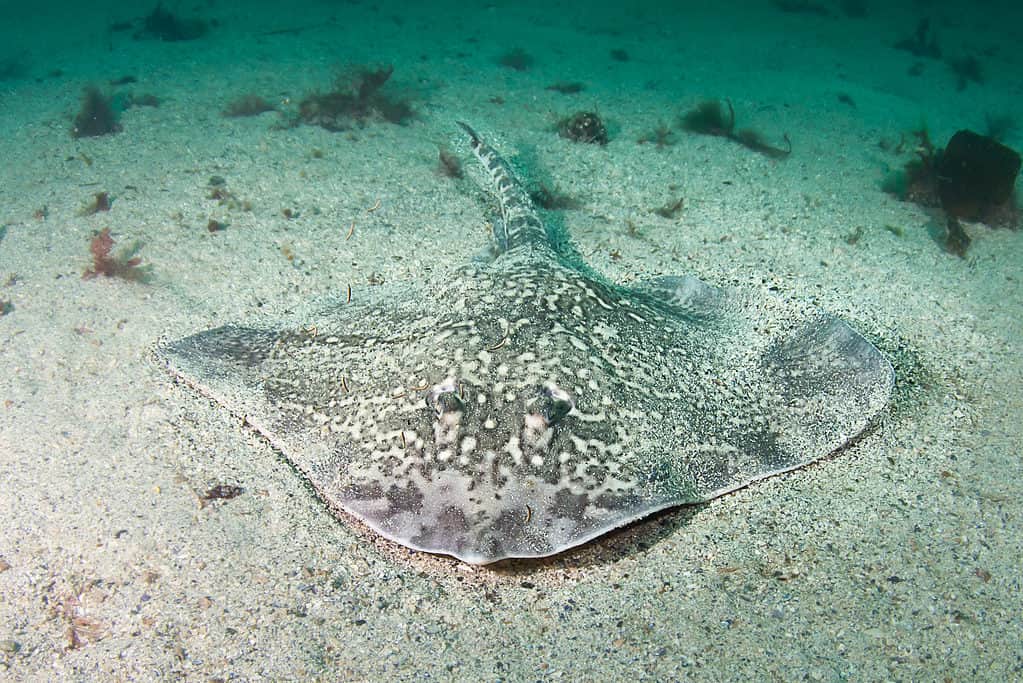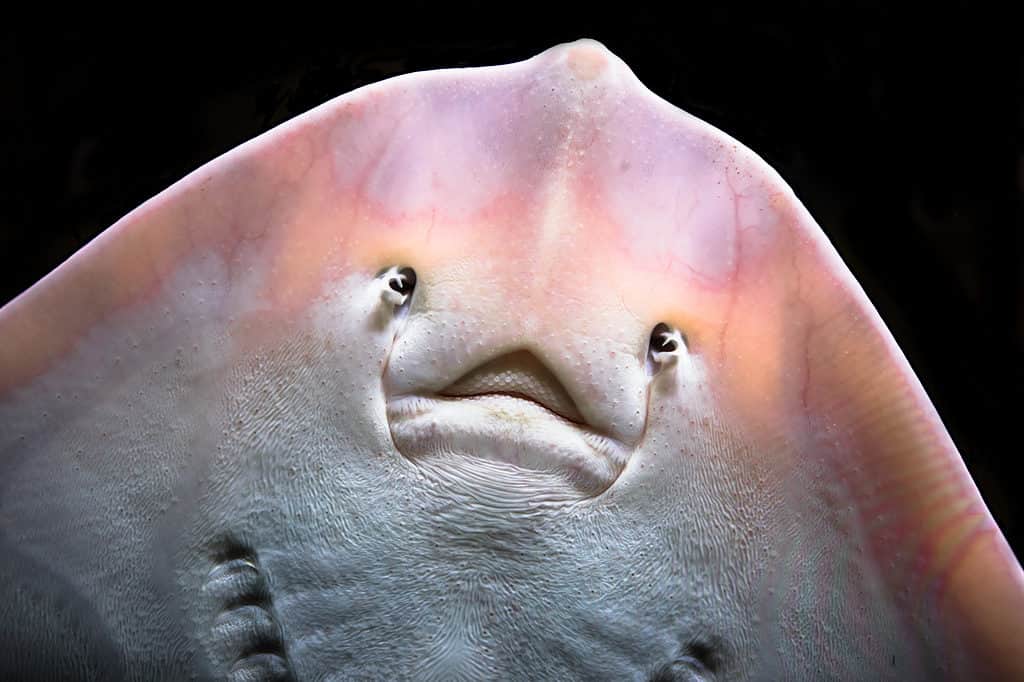Thornback Ray
Raja clavata
Thornback rays have spines on their backs!
Advertisement
Thornback Ray Scientific Classification
- Kingdom
- Animalia
- Phylum
- Chordata
- Class
- Chondrichthyes
- Order
- Rajiformes
- Family
- Rajidae
- Genus
- Raja
- Scientific Name
- Raja clavata
Read our Complete Guide to Classification of Animals.
Thornback Ray Conservation Status
Thornback Ray Facts
- Prey
- Crustaceans, small fish, sand eels
- Name Of Young
- Pup
- Group Behavior
- Social
- Fun Fact
- Thornback rays have spines on their backs!
- Biggest Threat
- Overfishing
- Most Distinctive Feature
- Spines on back
- Other Name(s)
- Thornback skate, maiden ray, rough ray
- Gestation Period
- 4-5 months
- Average Spawn Size
- 48-170 eggs
- Diet
- Carnivore
- Lifestyle
- Nocturnal
- Common Name
- Thornback ray
- Number Of Species
- 1
- Slogan
- The skate with the biggest spines!
Thornback Ray Physical Characteristics
- Color
- Brown
- Grey
- White
- Skin Type
- Spikes
- Age of Sexual Maturity
- 7-8 years
- Venomous
- No
- Aggression
- Low
View all of the Thornback Ray images!
Thornback Ray Summary
The thornback ray is a cartilaginous fish preferring to dwell on sea floors either in deeper water or along the coast. Its alternate name, the thornback skate, is more accurate given that this fish is actually a skate, not a ray. It lives in the Atlantic and Indian Oceans, mostly along European and West African coastlines. This skate is a popular sport fish with anglers, though many choose to catch and release it due to its conservation status.
Fish Facts
Thornback Ray Fish Facts
- Related to sharks: This species is closely related to sharks, having diverged from them about 200 million years ago. In fact, some shark species are closer to rays and skates than to other sharks!
- Spines, not stingers: Thornback rays are actually skates, which means they have spines on their backs instead of stingers on their tails.
- Powerful jaws: Their mouths don’t look all that fearsome, but they pack a mean bite! Their teeth are also extremely sharp.
- Good eating: Even though the IUCN lists this species as Near Threatened, many people still enjoy eating its lean meat.
- Bottom-dwelling: This fish likes to hang out on sea floors, disguising itself against the sediment. Because the species is nocturnal, it usually burrows into the sand or mud during the day and comes out at night to cruise around for food.
Thornback Ray Classification and Scientific Name
The scientific name for the thornback ray is Raja clavata. Alternate names for this fish include thornback skate, maiden ray, and rough ray. Although its common name includes the word “ray,” it is technically a skate. Among other differences, rays have stingers on their tails while skates typically have spines on their backs.
The thornback ray belongs to the class Chondrichthyes, which comprises cartilaginous fishes. These fish primarily have cartilage instead of bone. Its subclass, Elasmobranchii, includes sharks, rays, skates, and sawfish. It further belongs to the order Rajiformes (over 500 species of rays and skates), the family Rajidae (over 200 species of skates), and the genus Raja (16 species of skates).
Thornback Ray Appearance

Its alternate name, the thornback skate, is more accurate given that this fish is actually a skate, not a ray.
©Joern_k/Shutterstock.com
The thornback ray is flat and kite-shaped with distinctive wings ending in points. It uses these wings to move underwater. Its tail is long and fleshy, but like the tails of all other skates, it lacks a stinger. It may, however, have spines. The dorsum is prickly, though large females may also have spines on their ventral region. Juveniles and large males may have spines along the bottoms of their snouts and the edges of their discs. Adults often have “bucklers” (button-like growths) at the bases of their disc spines.
In all individuals, the dorsum is brownish or greyish with brown or grey spots. The underbelly is white, fading to grey at the edges. Though this species has a small downward-facing mouth, its jaws are powerful. Two nostrils just above the mouth are sometimes mistaken for eyes. The rostrum (snout) is rounded.
Male thornback rays grow up to 41 inches in length while females are somewhat larger, up to 55 inches in length. However, the average length for this species is 33.5 inches. Disc width (width from wingtip to wingtip) for adults is a minimum of 15 inches. The largest individual on record weighed just under 40 pounds.
Thornback Ray Distribution, Population, and Habitat
Thornback rays thrive in marine environments, typically coastal waters. Though they are saltwater fish, they are capable of surviving in lower salinity. They are also demersal, meaning they tend to lurk along the sea floor. This species inhabits areas of the Atlantic and Southwest Indian Oceans, notably along the coasts of Europe and West and South Africa. It also lives in the Mediterranean and Black Seas.
These fish prefer to live at a depth of approximately 30-100 feet, though scientists have discovered some individuals at depths of nearly 3,350 feet. They often camouflage themselves in sediments on the ocean floor like mud, sand, and gravel, especially during the day. Their coloration makes it easy for them to blend in.
Conservationists do not know the exact number of thornback rays in the world, but they believe that their populations are declining. For this reason, the IUCN lists this species as Near Threatened.
Below is a list of the 67 countries and islands this fish inhabits.
| Africa | Europe | Asia |
|---|---|---|
| Algeria | Albania | Cyprus |
| Angola | Belgium | Israel |
| Benin | Bosnia and Herzegovina | Lebanon |
| Cameroon | Bulgaria | Syria |
| Canary Islands | Channel Islands | Turkey |
| Congo | Croatia | |
| The Democratic Republic of Congo | Denmark | |
| Cote d’Ivoire | Faroe Islands | |
| Egypt | France | |
| Equatorial Guinea | Germany | |
| Gabon | Gibraltar | |
| Gambia | Greece | |
| Ghana | Iceland | |
| Guinea | Ireland | |
| Guinea-Bissau | Isle of Man | |
| Liberia | Italy | |
| Libya | Malta | |
| Madagascar | Monaco | |
| Mauritius | Montenegro | |
| Morocco | Netherlands | |
| Namibia | Norway | |
| Nigeria | Poland | |
| São Tomé and Príncipe | Portugal | |
| Senegal | Romania | |
| Sierra Leone | Russia | |
| South Africa | Slovenia | |
| Togo | Spain | |
| Tunisia | Sweden | |
| West Sahara | United Kingdom – England | |
| United Kingdom – Wales | ||
| United Kingdom – Northern Ireland | ||
| United Kingdom – Scotland | ||
| Ukraine |
Thornback Ray Evolution and History
Thornback rays and other members of the Rajiformes order have left behind relatively little evidence of their evolutionary history. This is due to their cartilaginous skeletons, which are softer than bone and therefore do not easily fossilize. Northern Africa and southern Europe have yielded the majority of the earliest fossils, mostly in the form of teeth and scales.
The available evidence suggests that the thornback ray’s ancestors date back to the Lower Jurassic 150 million years ago, though they most likely began to split off from sharks as far back as 200 million years. Most of the current taxonomical groupings appear to have developed from the Upper Cretaceous 100 million years ago to the Paleocene 50 million years ago. Some scientists speculate that rays and skates have experienced greater speciation (diversity) than sharks due to the more diverse range of benthic (sea floor) environments. Strangely enough, some shark species remain more closely related to rays and skates than to other sharks.
The phylogenetic development of the thornback ray is uncertain, though scientists have studied European populations to measure their diversity. They found that populations in the Mediterranean, Adriatic, and Black Seas all shared a single mitochondrial haplotype, which is a region of DNA that helps to show maternal lineages. British populations, however, had a second mitochondrial haplotype that differentiated them from some other European populations. Evidence suggests that thornback ray numbers expanded significantly between 580,000 and 362,000 years ago.
Thornback Ray Predators and Prey
Thornback rays are carnivorous, opportunistic feeders that survive by camouflaging themselves on the ocean floor. As nocturnal animals, they are usually active at night and rest during the day. Their favored method of hunting is to grab prey as it swims by or as it rests on the sea bed. Despite their ability to hide, they have a number of natural predators besides humans.
What Do Thornback Rays Eat?
Thornback rays, both adults and juveniles, eat crustaceans like amphipods, shrimp, and crabs. Fully grown individuals also enjoy sand eels and other small fish. Because of their powerful jaws and sharp teeth, they are able to crack the hard outer shells of crustaceans.
What Eats Thornback Rays?
Humans are one of the primary predators of the thornback ray. Other potential threats include seals and shark species like angel sharks and bluntnose sixgill sharks. Some fish, like the Atlantic cod or grey gurnard, also prey on this species.
Thornback Ray Reproduction and Lifespan

Thornback rays thrive in marine environments, typically coastal waters. Though they are saltwater fish, they are capable of surviving in lower salinity.
©kirpad/Shutterstock.com
Thornback rays prefer deeper waters in winter, but when temperatures rise, they move to shallower waters to breed. Females typically migrate a month before the males, who follow afterward. Their breeding season lasts from February to September, though June sees the most activity. The polyandrous females usually mate with more than one male.
This species is oviparous, meaning it lays eggs that then develop and hatch outside the mother’s body. It is also characterized by single oviparity, which means each egg contains only one embryo. The eggs are ovular and pointed at both ends. Females usually only lay once or twice a year, producing up to 170 eggs annually, though the average number is 48-74.
Females lay their eggs in winter, spring, or summer, depositing them in the sediment on the sea floor. The eggs hatch after four to five months. The newly hatched pups are between 4.3 and 5.1 inches long. They survive by feeding on the yolk from the eggs. Sexual maturity occurs at about seven to eight years of age, usually sooner for males than females. The maximum lifespan for this species is 15 years.
Thornback Ray in Fishing and Cooking
It is legal in most places to fish for thornback rays, both recreationally and commercially. Though it may come as a surprise to many, some people enjoy eating this fish.
Fishing
The best time to fish for this fish near shore is from May to September, though they move inland as early as February. After September, they return to deeper waters. Anglers are likely to find these fish swimming in areas with sediments like sand, mud, or gravel. Rocky or rough ground is unlikely to harbour this species.
The best bait for thornback rays is whole small fish like sprats, though parts of larger fish like mackerel, herring, or pilchard may also generate good results. Fishermen can also try using bait like sand eels, worms, and crustaceans. Anyone attempting to handle this fish after catching it should exercise caution as both its teeth and its spines are sharp.
Commercial fisheries also fish for this species in various areas like the Irish and Celtic Seas, the eastern English Channel, the North Sea, Skagerrak, and Kattegat. Methods of catching this fish include seines, otter trawls, bottom trawls, and trammel nets. The United Kingdom’s Southern IFCA (Inland Fisheries and Conservation Authorities) estimates that fisheries caught 107 tons of thornback rays in their district in 2019.
Cooking and Eating
Thornback rays are good for eating with a number of acceptable preparation methods including frying, baking, or sautéing. With leaner meat like this, it’s best to prepare it with oil or sauce. The UK’s The Telegraph featured this recipe for thornback ray with cockles and brown butter. BBC Good Food recommends preparing this fish with buttery parsley and capers. For those interested in a more comprehensive experience, this guide shows readers how to catch, skin, and cook this unique fish.
Because its mean is so lean, this species is an excellent choice for people watching their fat intake. 100 grams of thornback ray meat contains about 68 calories, 14.2 grams of protein, 0.9 grams of fat, and 0.7 grams of carbohydrate.
Related Animals:
View all 133 animals that start with TThornback Ray FAQs (Frequently Asked Questions)
Where are thornback rays found?
Thornback rays are found mainly in the eastern Atlantic and southwest Indian Oceans. They inhabit marine environments along the coasts of Europe, western Africa, and southern Africa.
Do thornback rays sting?
Thornback rays are actually skates and therefore do not sting with their tails as true rays do. Instead, they have spines on their backs and tails.
How do you identify a thornback ray?
Thornback rays have brownish or greyish backs with dark and light spots. They also have spines on their backs and tails, which are larger than those of similar skates.
Can you eat thornback rays?
Yes, thornback rays are good for eating. However, there is controversy around the practice as their populations are decreasing.
Thank you for reading! Have some feedback for us? Contact the AZ Animals editorial team.
Sources
- / Accessed December 7, 2022
- / Accessed December 7, 2022
- / Accessed December 7, 2022
- / Accessed December 7, 2022
- / Accessed December 7, 2022
- / Accessed December 7, 2022
- / Accessed December 7, 2022
- / Accessed December 7, 2022
- / Accessed December 7, 2022
- / Accessed December 7, 2022
- / Accessed December 7, 2022
- / Accessed December 7, 2022
- / Accessed December 7, 2022
- / Accessed December 7, 2022


















